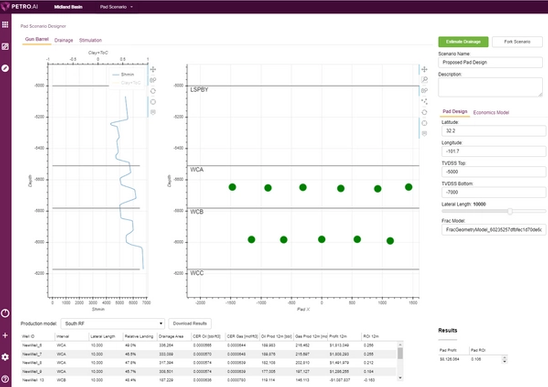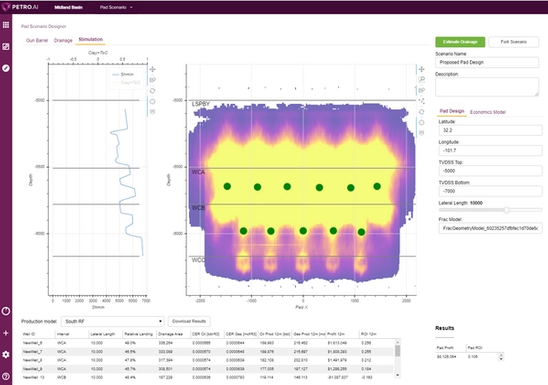Petro.ai: Provides the only fully AI platform in O&G. Deep learning, shallow learning, adversarial networks combine to form a highly accurate, verifiable view of the complex subsurface.
Well Spacing: Leveraging science, building intuition, well spacing tradeoffs are the new solution in the all-encompassing AI of Petro.ai, where data models and API interact.
AI: The more you put in, the more insights come back. Domain knowledge based. Easy for an engineer to use. Petro.ai is where AI meets reality and provides real, useable, trustworthy alternatives.

Artificial Intelligence, AI, is profoundly changing well spacing analysis across the O&G Industry. Single well assessment alone does not provide the insight to develop the multi-well drilling tradeoffs necessary to optimize unconventional acreage. Only AI powered solutions allow for complex Cube optimization.
Petro.ai is a specific breed of AI built for O&G. And when applied to well spacing problems, that AI builds the complex models with the complex intelligence already available today.
“In Petro.ai, the user interfaces by upgrading models, tuning models, and having that cascade through the rest of the system” Dr. Troy Ruths, CEO of Petro.ai, elaborates, “The user interacts with the model, like in the Pad Designer where they’re moving points and seeing the drainage change creating new ROI predictions. What’s important about the Petro.ai we’ve developed is, it comes pre-built with lots of knowledge, lots of intelligence, but it can also adapt to your rocks, your geology. You can plug in and Petro.ai will take your inputs and create your models.”

There are three integral parts of any AI platform. The first is data. “You have to have a lot of data,” Dr. Derek Ruths, Chief Data Scientist of Petro.ai emphasizes, “and you have to have a confidence in the quality of the data. It’s not just about the data, it’s about the annotation of that data. Does this data signal a good well or a bad well? You need to have that annotated data.”
This is where Petro.ai differentiates—cleaning your data, understanding the full geomechanical calculation suite for well spacing determination, and developing integrated apps that reveal important correlations. Forbes recently observed, “It’s critical for decision-makers to rapidly see the telltale signals in their data that will impact their business. Analysts, for their part, shouldn’t have to spend 80%–90% of their time manually searching through data. Machines should do the heavy lifting: number-crunching, correlating and trendspotting.”
The second mainstay of AI is the pattern recognition strengthened by those large amounts of data that allow the system to learn. Dr. Derek Ruths explains, “Typically when you’re looking at AI powered solutions, particularly early on, we’re talking about highly integrated AI solutions.So that means you’re taking this AI, these inferences, and saying here’s a pattern I’ve detected—you need to give that to humans immediately. The AI develops functional alternatives, tradeoffs that the engineer evaluates. AI is not superior to the human intellect, it provides complimentary perspectives that allows for broader, deeper choices.”

“I think the interesting thing is we’re dealing with so many unknowns in the subsurface and so many unknowns everywhere, an AI is necessary, it’s like intuition built into the system,” Dr. Troy Ruths adds. “That’s different than a physical simulator that doesn’t have intuition built in, just science. What we’re doing with the drainage program is intuition for the engineer. If you could see it in one picture, it would be the Pad Designer. It’s complexity at work, so when you move a point, there’s a cascade of calculations and machinery that are very complex, but it’s handling it for you. It’s coming back with something explainable. It’s giving you a result that’s digestible and something you can apply. It’s giving you a tool that you can talk to.”
The third aspect of AI is focusing that pattern recognition. Dr. Derek Ruths continues, “You can help the AI focus on what it needs to focus on which increases accuracy and confidence in that accuracy.




